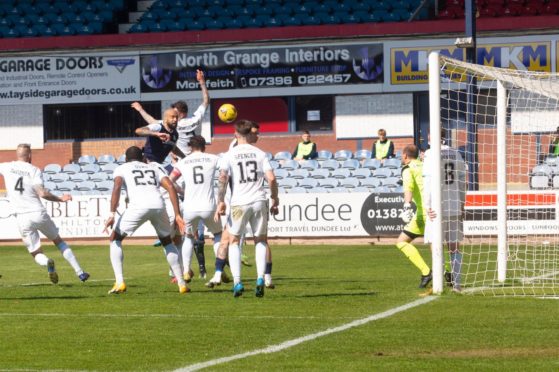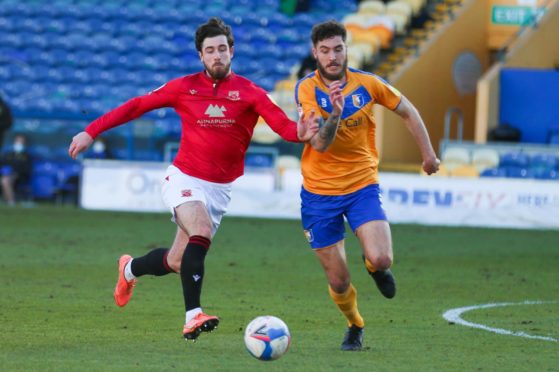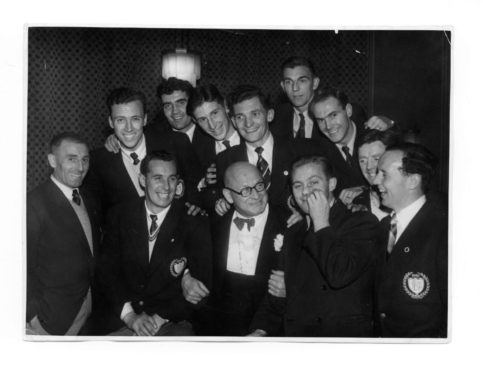Ryan Sweeney has become Dundee boss James McPake’s third signing as a Premiership manager.
The 24-year-old central defender arrives at Dens Park looking to realise the early promise that saw Stoke City spend £250,000 to sign him from AFC Wimbledon.
Dundee skipper Charlie Adam was a regular in the midfield in those days for the Potters, though they never took the field together.
In fact, Sweeney wasn’t able to break into the Stoke first team during his time at the Britannia at all.
However, he has plenty of experience from time spent with the Dons, Mansfield Town and Bristol Rovers in Leagues One and Two down south.
Now, the man who has promised he’ll “run through a brick wall” for his new team is preparing for a new chapter north of the border.
And a chance to finally play a senior match with Dundee’s most experienced player, five years after joining the same club for the first time.
But how can he dislodge the current central defensive pairing at Dens Park?
The Ashcroft-Fontaine axis
Lee Ashcroft and Liam Fontaine showed last season that, not only do they have defensive nous, they bring goals to the team too.
In fact, they have brought more goals than any other defensive pairing to date for the club.
The centre-backs played 24 times together last term, picking up four clean sheets but, crucially, finding the net a remarkable 11 times.
Ashcroft snaffled both the Player’s Player and Fan’s Player of the Year trophies for his exceptional year in front of goal.
Before joining Dundee the 27-year-old had scored 14 goals across four seasons at each of Kilmarnock and Dunfermline.
In dark blue, he managed to bump that figure up by 50% after finding the net seven times in all competitions, including the goal that ultimately won the Dark Blues promotion back to the top flight.
Fontaine, a veteran of 18 seasons and counting now, had never scored more than two goals in one campaign.
That was until he joined this Dark Blues side with set-piece delivery from the likes of Adam and Paul McGowan.
Last term Fontaine doubled his best ever tally with four goals, including three in just four games in December.
And No 4 turned out to be a crucial one: the winner against Raith Rovers on the penultimate weekend of the league season.
That goal allowed Dundee to finish second ahead of the Kirkcaldy club by beating Queen of the South the following week.
What Sweeney can bring
Neither was brought in to score goals but rather to stop the opposition doing so.
And that’s the task of new boy Ryan Sweeney, though he isn’t averse to a goal or two of his own.
Last season at Mansfield Town in England’s League Two he notched four times – three in the league and one in the Football League Trophy.
The 24-year-old has 10 goals to his name from 183 appearances and the video below shows his last goal back in April.
Notably, though, he helped Mansfield to 11 clean sheets in 42 appearances last season.
And that’s where he can boast a better record than the current incumbents of the central defensive positions at Dens.
Keeping the opposition out wasn’t Dundee’s strong point last term, though they often had the firepower to undo that at the other end.
In fact, it took 17 games for the Ashcroft-Fontaine partnership to notch clean sheet No 2 after getting the first in their league debut together.
From that second shut-out they conceded just five goals in eight matches.
There may also be competition from other areas for Sweeney, too.
Youngster Sam Fisher will fancy a bit more first-team football after getting a taster last season in his four outings.
Jordan McGhee also took his fair share of shifts at central defence, though he’s made himself a vital part of the Dundee midfield.
For Sweeney, though, the main target is to dislodge two of Dundee’s most important signings of their promotion season.
Not an easy task but one he has stated he is more than up for.
Dundee’s top-scoring defenders
Ashcroft headed his way into the hearts of Dundee fans everywhere with his dominant displays at both ends of the park.
His two goals at Alloa set the Dark Blues on their lengthy run of form that saw them eventually win promotion through the play-offs.
And not just those two but in total the defender scored six times in the final 13 matches, helping his team to wins over the Wasps and Dunfermline and rescuing draws against Morton and Inverness.
And then putting Dundee well in control at Rugby Park.
With those seven goals, Ashcroft has put himself among the club’s most lethal defenders.
Trawling the record books, those seven goals match a season tally achieved by Alex Stuart in 1967/68.
Bettered only by Alfie Boyd in 1950/51, who got nine that season – more than the great Billy Steel in his debut season.
Now, the argument comes over what positions are classified as defenders in the modern way of thinking.
Boyd was classed as a wing-half, a position that could be seen in modern days as a wide midfielder or wing-back.
In total, Boyd scored 27 goals for Dundee and captained the Dark Blues to a League Cup win but was four short of their top-scoring defender of all-time.
Alex Stuart netted 31 times between 1960 and 1969, including that seven stated earlier in his penultimate campaign.
The great Doug Cowie scored 24 goals between 1946 and 1961 while Bobby Wilson managed 17 between 1965 and 1976.
Next on the list are Gordon Chisholm (1987-92) and Napper Thomson (1913-27) with 16 goals each.
Though Ashcroft has some catching up to do still, his combination with Fontaine racking up 11 goals in one season is a modern-day record for a Dundee defensive duo.




